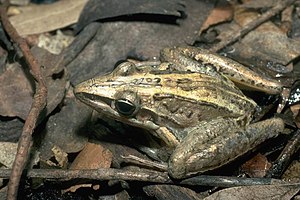Litoria
| Litoria | ||||||||||||
|---|---|---|---|---|---|---|---|---|---|---|---|---|

Litoria nasuta |
||||||||||||
| Systematics | ||||||||||||
|
||||||||||||
| Scientific name of the subfamily | ||||||||||||
| Litoriinae | ||||||||||||
| Dubois & Frétey , 2016 | ||||||||||||
| Scientific name of the genus | ||||||||||||
| Litoria | ||||||||||||
| Tschudi , 1858 |
Litoria is the most species-rich genus of the Australian tree frogs (Pelodryadidae) and at the same time the only genus of the subfamily Litoriinae . The genus is distributed on the Australian continent including Tasmania , New Guinea , the Bismarck Archipelago , the Lesser Sunda Islands , the Solomon Islands and Timor . Species were introduced by humanson several other islands (e.g. New Caledonia , New Zealand , Guam ).
features
All species of the genus Litoria have long been part of the family of tree frogs considered and there even as the European tree frog ( Hyla arborea ) in the genus Hyla out. All species with the characteristics of the tree frogs living in Australia and New Guinea were later placed in the genus Litoria .
Many species were transferred from the genus Litoria to other genera for phylogenetic reasons, for example to the genera Nyctimystes and Ranoidea from the subfamily Pelodryadinae within the family of the Australian tree frogs.
Systematics
In current systematic reviews, 93 species are assigned to the genus Litoria .
As of April 14, 2020
- Litoriinae
- Litoria adelaidensis (Gray, 1841)
- Litoria albolabris (Wandolleck, 1911)
- Litoria amboinensis (Horst, 1883)
- Litoria angiana (Boulenger, 1915)
- Litoria arfakiana (Peters & Doria, 1878)
- Litoria aurifera Anstis, Tyler, Roberts, Price & Doughty, 2010
- Litoria axillaris Doughty, 2011
- Litoria biakensis Günther, 2006
- Litoria bibonius Kraus & Allison, 2004
- Litoria bicolor (Gray, 1842)
- Litoria burrowsi (Scott, 1942)
- Litoria capitula (Tyler, 1968)
- Litoria chloristona Menzies, Richards & Tyler, 2008
- Litoria chloronota (Boulenger, 1911)
- Litoria chrisdahli Richards, 2007
- Litoria christianbergmanni Günther, 2008
- Litoria congenita (Peters & Doria, 1878)
- Litoria contrastens (Tyler, 1968)
- Litoria cooloolensis Liem, 1974
- Litoria Coplandi (Tyler, 1968)
- Litoria corbeni (Wells & Wellington, 1985)
- Litoria darlingtoni (Loveridge, 1945)
- Litoria dentata (Keferstein, 1868)
- Litoria dorsalis Macleay, 1878
- Litoria electrica Ingram & Corben, 1990
- Litoria eurynastes Menzies, Richards & Tyler, 2008
- Litoria everetti (Boulenger, 1897)
- Litoria ewingii (Duméril & Bibron, 1841)
- Litoria fallax (Peters, 1880)
- Litoria flavescens Kraus & Allison, 2004
- Litoria freycineti Tschudi, 1838
- Litoria gasconi Richards, Oliver, Krey & Tjaturadi, 2009
- Litoria Havina Menzies, 1993
- Litoria hilli Hiaso & Richards, 2006
- Litoria humboldtorum Günther, 2006
- Litoria inermis (Peters, 1867)
- Litoria iris (Tyler, 1962)
- Litoria jervisiensis (Duméril & Bibron, 1841)
- Litoria latopalmata Günther, 1867
- Litoria Leucova (Tyler, 1968)
- Litoria littlejohni White, Whitford & Mahony, 1994
- Litoria lodesdema Menzies, Richards & Tyler, 2008
- Litoria longicrus (Boulenger, 1911)
- Litoria longirostris Tyler & Davies, 1977
- Litoria lutea (Boulenger, 1887)
- Litoria majikthise Johnston & Richards, 1994
- Litoria mareku Günther, 2008
- Litoria megalops Richards & Iskandar, 2006
- Litoria meiriana (Tyler, 1969)
- Litoria microbelos (Cogger, 1966)
- Litoria micromembrana (Tyler, 1963)
- Litoria modica (Tyler, 1968)
- Litoria mucro Menzies, 1993
- Litoria multiplica (Tyler, 1964)
- Litoria mystax (Van Kampen, 1906)
- Litoria nasuta (Gray, 1842)
- Litoria nigrofrenata (Günther, 1867)
- Litoria nigropunctata (Meyer, 1875)
- Litoria oenicolen Menzies & Doubt, 1974
- Litoria ollauro Menzies, 1993
- Litoria olongburensis Liem & Ingram, 1977
- Litoria pallida Davies, Martin, and Watson, 1983
- Litoria paraewingi Watson, Loftus-Hills & Littlejohn, 1971
- Litoria peronii (Tschudi, 1838)
- Litoria personata Tyler, Davies & Martin, 1978
- Litoria pinocchio Oliver, Günther, Mumpuni & Richards, 2019
- Litoria pronimia Menzies, 1993
- Litoria prora (Menzies, 1969)
- Litoria pygmaea (Meyer, 1875)
- Litoria quadrilineata Tyler & Parker, 1974
- Litoria revelata Ingram, Corben & Hosmer, 1982
- Litoria rothii (De Vis, 1884)
- Litoria rubella (Gray, 1842)
- Litoria rubrops Kraus & Allison, 2004
- Litoria scabra Günther & Richards, 2005
- Litoria singadanae Richards, 2005
- Litoria spartacus Richards & Oliver, 2006
- Litoria staccato Doughty & Anstis, 2007
- Litoria thesaurensis (Peters, 1877)
- Litoria timida Tyler & Parker, 1972
- Litoria tornieri (Nieden, 1923)
- Litoria tyleri Martin, Watson, Gartside, Littlejohn & Loftus-Hills, 1979
- Litoria umarensis Günther, 2004
- Litoria umbonata Tyler & Davies, 1983
- Litoria verae Günther, 2004
- Litoria verreauxii (Duméril, 1853)
- Litoria viranula Menzies, Richards & Tyler, 2008
- Litoria vivissimia Oliver, Richards & Donnellan, 2019
- Litoria vocivincens Menzies, 1972
- Litoria wapogaensis Richards & Iskandar, 2001
- Litoria watjulumensis (Copland, 1957)
- Litoria wisselensis (Tyler, 1968)
- Litoria wollastoni (Boulenger, 1914)
Individual evidence
- ↑ Alain & T. Dubois Frétey: A new noun for a subfamily of frogs (Amphibia, Anura). Dumerilia. 6, pp. 17-23, Paris 2016
- ^ Darrel R. Frost: Litoria Tschudi, 1838 . In: Amphibian Species of the World: an Online Reference . Version 6.0. American Museum of Natural History, New York 1998–2019. Retrieved August 5, 2019
Web links
- Darrel R. Frost: Litoria Tschudi, 1838 . In: Amphibian Species of the World: an Online Reference . Version 6.0. American Museum of Natural History, New York 1998–2019. Retrieved August 5, 2019
